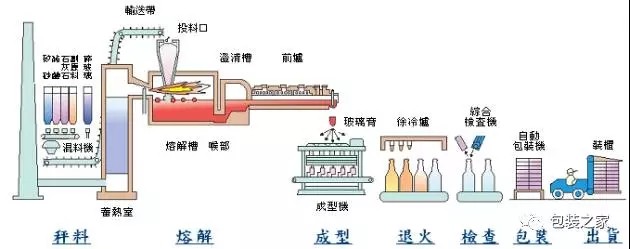With the improvement of processing technology, current glass containers have expanded from traditional consumer products to medical products and industrial products, making them increasingly useful as packaging containers. Glass packaging materials are also one of the major domestic packaging materials. The following will briefly introduce the glass bottle packaging process and technology.
Glass bottle features
First of all, we need to understand the main characteristics of glass packaging containers, summed up in the following five points:
(1) It has good barrier properties, and can maintain the original flavor of food for a long period of time without deterioration.
(2) It has good heat resistance and is suitable for progressive high-temperature sterilization and hot filling at 100°C or even 200°C. It can be microwave-heated after the lid is opened, which is a characteristic that the general food packaging does not have.
(3) Stable chemical and physical properties, acid and alkali resistance, suitable for long-term preservation.
(4) It has good transparency and is not easily damaged.
(5) The glass bottle can be used repeatedly, which can reduce the cost of packaging.
Secondly, to understand how it compares with some of the other features that are mainly used for bottled packaging materials, summarized in Table 1.
characteristic
glass
iron
aluminum
PET
paper
Density ( g/m l)
2.5
7.9
2.7
1.0-1.2
0.8-1.2
Hermeticity
Have
Have
Have
limited
limited
Transparent
Have
No
No
Have
No
health
Have
Have
Have
limited
limited
Tasteless
Tasteless
/
/
/
/
Container weight
( 500ml )
weight
( 210g )
light
( 40g )
very light
( 20g )
very light
( 20g )
very light
( 15g )
Brittleness
Very crisp
Plastic
Plastic
Plastic
Plastic
Rupture risk
Very high
no
no
no
no
Energy consumption per container
Very high
medium
Very high
low
Very low
Wastewater
medium
medium
medium
low
high
Amount recovered
Very high
high
high
Very low
Very high
Multipurpose
Have
no
no
limited
no
Here's a specific introduction to the production process and technology of glass bottles.
Glass bottle production process
Glass bottle production and processing process is as shown in Figure 1 below:

Figure 1 glass bottle processing
1, raw material ratio:
Usually the glass bottle raw material formula (soda lime glass bottle) is mainly quartz sand, soda ash, limestone, sodium nitrate, nickel oxide, broken glass. Although smashed glass was added to the formulation, it played an important role in the entire formulation, which can reduce raw material costs, reduce processing energy consumption, increase melting rate, facilitate clarification and homogenization, and prolong the service life of the kiln.
The addition of broken glass has many important functions, but there are still some drawbacks, such as volatile components caused by its volatility, the impact of refractory erosion on the quality of the glass, will produce secondary bubbles, easy to bring in impurities, grain size discomfort will affect the melting .
The above disadvantages are not without solutions. The specific solutions are as follows:
(1) Supplementation of component fluctuations due to volatilization and depletion
The full analysis of the broken glass and the analytical content of the original glass are compared, and the composition and content to be supplemented are determined and then calculated to see if the composition requirements of the design are satisfied. In actual production, the glass density, the coefficient of thermal expansion coefficient, and the ring shear stress can be tested to timely grasp the changes in the composition of the glass, so that the glass composition is controlled within the design range.
(2) Proper proportion of broken glass
The general manufacturer believes that the use of more than 50% of cullet when melting soda-lime-silica glass will reduce the quality of the glass, and the mechanical strength will become brittle, but the appropriate additional oxidants, fining agents, fluxes, and partially volatile components ( B 2 O 3 , Na 2 O, etc.) The full homogenization of the glass does not affect the color and properties.
(3) to ensure the appropriate piece of broken glass
When the particle size of the cullet is less than 0.25mm and the particle size is between 2-20mm , it has a good effect on melting. In the production, the particle size of the latter is used to reduce the power used for crushing, and comprehensively taking into account the processing factors of various shapes of broken glass. , Usually 20-40mm granularity.
18"14.5g Dip Paint Shirt Hanger
Classic Design Powder Shirt Hanger,Excellent Workmanship Powder Shirt Hanger,Non Slip Powder Shirt Hanger,New Creative Powder Shirt Hanger
SHAOXING DINGLI METAL CLOTHESHORSE CO., LTD , https://www.dingliclothrack.com